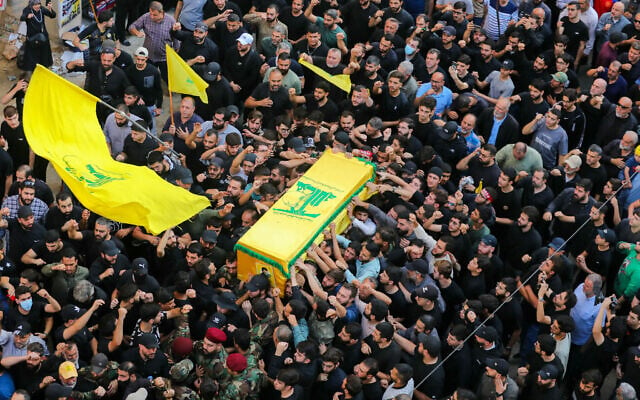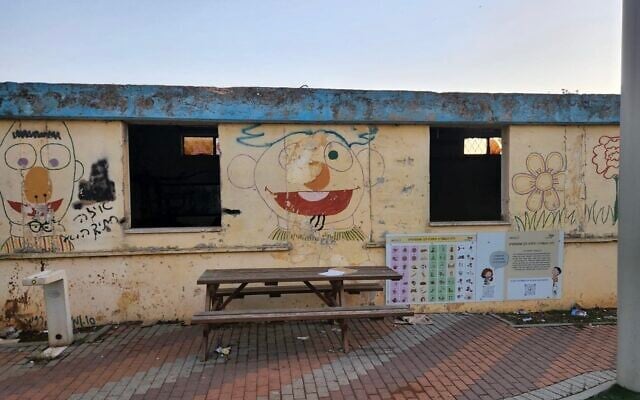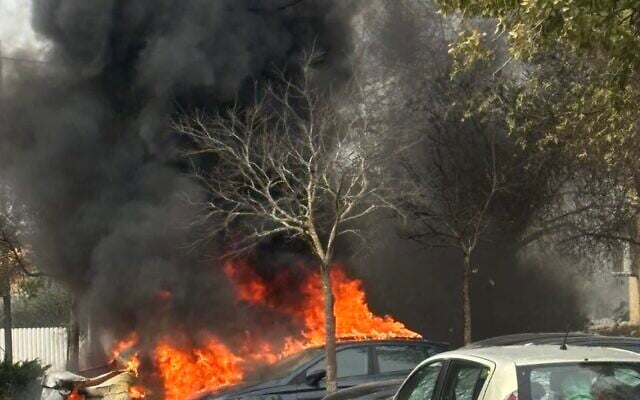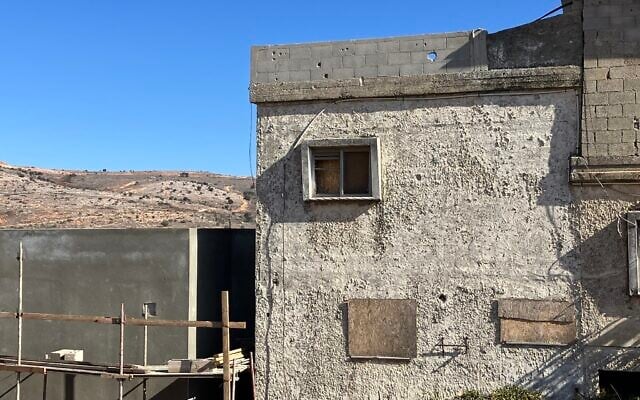AVIVIM — As 20 kindergarten children sang a song during a music lesson on Wednesday morning in this Lebanon border town, teacher Tsila Yakuti stepped outside for a few minutes to speak with The Times of Israel in the school’s colorful front yard.
“The children are okay. They don’t have real anxiety,” said Yakuti, standing near a wooden teepee and a vegetable garden with purple and pale heads of lettuce. “They’re used to the situation, but they ask about every loud noise and boom.”
The children of this hilltop farming community participate in regular drills to practice entering the building’s bomb shelter in the event of incoming missiles or rockets from Lebanon, whose border lies mere steps from the fence that surrounds Avivim, Yakuti said.
“I’ve been a teacher here for 30 years,” she said. “And it’s the first time I’m scared to come to work.”
She paused for a moment and then offered her guest a sfinj, a Moroccan doughnut made in honor of the upcoming Hanukkah holiday.
Yakuti’s warm hospitality laced with underlying fear is typical of the 500-strong border town, which has been on edge since Israel’s targeted assassination of Hezbollah’s military chief, Haytham Ali Tabatabai, on November 23.

The Israel Defense Forces has geared up for a potential response by the Iran-backed terror organization. Although there has been no formal change in the guidelines for civilians, residents say they are waiting tensely for some kind of retaliation.
The Times of Israel’s visit also coincided with the eve of the first anniversary of the November 2024 ceasefire with the terror group, after more than a year of war had left much of Israel’s north heavily damaged and deserted.
Avivim residents were among the 60,000 people of 32 communities in northern Israel who were evacuated beginning on October 8, 2023, when Hezbollah and allied groups began firing into Israel in solidarity with Hamas. A day earlier, thousands of Hamas-led terrorists had invaded southern Israel, killing some 1,200 people, mostly civilians, and abducting 251 people to the Gaza Strip.
About 70% of Avivim’s displaced residents have returned, said Shmulik Menachem, a member of the residents’ committee. Almost all its homes suffered damage, along with community buildings and infrastructure. Many of the chicken coops were hit, as were peach and plum trees. The Avivim winery was destroyed.

Under a clear sky on Wednesday, construction workers were repairing the library, restoring houses, and building new bomb shelters. At the same time, there was the lingering smell of fires from Hezbollah rocket attacks, and scattered glass that had yet to be cleaned up.

The fighting in the north saw daily indiscriminate Hezbollah attacks on communities near the border, and occasionally further south, drawing Israeli reprisals. The simmering conflict broke open in September 2024 as Israel decapitated the terror group’s leadership and launched a limited ground invasion into southern Lebanon amid intensified fire on the north.
Over 13 months, the attacks claimed the lives of 46 civilians inside Israel and 83 Israeli soldiers, with hundreds more wounded.

‘The cease between fires’
The war came to a lull with a temporary truce on November 27, 2024, followed by a ceasefire agreement in February 2025. Since then, Israel has carried out sporadic attacks on what it identifies as Hezbollah members in southern Lebanon, and has left troops at five key locations across the border in a bid to ensure the terror group does not rebuild a military foothold along the frontier.
However, said Tal Beeri, research director of Alma Research and Education Center, “Hezbollah is acting as though they are rebuilding.”
Based on the center’s estimates, Hezbollah still has more than 20,000 rockets and drones in its arsenal. Beeri said the terror group is manufacturing weapons in a period that Alma Center staff calls “the cease between fires.”

“Hezbollah is still able to conduct focused attacks against Israel,” Beeri said. “But what will happen now, we don’t know.”
Lian Biton stood in front of the Avivim grocery store, which serves as the community’s meeting point, while a relative, Yitzhak Peretz, listened to music from a small transistor radio.
“We’re all worried,” said Biton as her daughter, Iscah, ate an ice cream cone. “We’re civilian shields.”
After living in a hotel in Tiberias for 16 months, she and other residents returned to Avivim when the February ceasefire took hold.
Shortly prior to that, in December 2024, the Defense Ministry and the Home Front Command signed an agreement with the Finance Ministry to build private bomb shelters in localities located up to five kilometers (about three miles) from the Lebanese border as part of a project dubbed Northern Shield.
In these areas, people must take immediate shelter once a siren signals an incoming rocket.

Until their bomb shelter is completed, Biton said that the closest place for her to go is a neighborhood shelter six minutes away from her house.
“How can I run there with my four daughters, aged nine, six, four, and two?” she said. “Many of my neighbors are panicking. I have a suitcase ready in case we have to leave.”
Parents won’t let their children go to the playground unaccompanied.

“We don’t know what Hezbollah’s response will be, but we know they will take revenge,” Biton said.
On the back terrace of the house that she shares with her husband, David, and their three children, Limor Biton (no relation to Lian Biton) pointed to the village of Bint Jbeil, a Hezbollah stronghold on the top of a nearby hill.
Even though she had heard Hezbollah “digging tunnels right near us, we weren’t really afraid before October 7,” Limor Biton said.
Although the IDF has blown up the tunnels, she said, “I’m still afraid of infiltrations. In 20 minutes, terrorists can get here.”
The windows of her home were shattered when a rocket slammed into the neighboring house during the war. Before the family moved back in after their evacuation, they had to repair the “damage left by rodents and insects, and clean away the mold and mildew,” she said.

“We came home, but we didn’t really come home,” said Limor Biton, adding that although they now have a new bomb shelter, “we live in fear.”
Her son, 16, rides to high school in nearby Kibbutz Sasa each day along the border fence.
“They’re all scared to go by the border,” she said, citing the 1970 attack on a school bus by Popular Front of the Liberation of Palestine terrorists that killed eight children and three adults.
“I tell my son not to be afraid, but our body betrays us,” she said. “We have no other place to go.”

